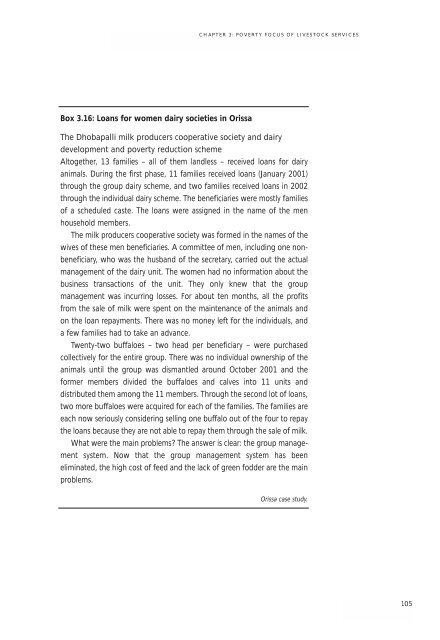Livestock Services and the Poor: A global initiative - IFAD
Livestock Services and the Poor: A global initiative - IFAD
Livestock Services and the Poor: A global initiative - IFAD
Create successful ePaper yourself
Turn your PDF publications into a flip-book with our unique Google optimized e-Paper software.
Box 3.16: Loans for women dairy societies in Orissa<br />
CHAPTER 3: POVERTY FOCUS OF LIVESTOCK SERVICES<br />
The Dhobapalli milk producers cooperative society <strong>and</strong> dairy<br />
development <strong>and</strong> poverty reduction scheme<br />
Altoge<strong>the</strong>r, 13 families – all of <strong>the</strong>m l<strong>and</strong>less – received loans for dairy<br />
animals. During <strong>the</strong> first phase, 11 families received loans (January 2001)<br />
through <strong>the</strong> group dairy scheme, <strong>and</strong> two families received loans in 2002<br />
through <strong>the</strong> individual dairy scheme. The beneficiaries were mostly families<br />
of a scheduled caste. The loans were assigned in <strong>the</strong> name of <strong>the</strong> men<br />
household members.<br />
The milk producers cooperative society was formed in <strong>the</strong> names of <strong>the</strong><br />
wives of <strong>the</strong>se men beneficiaries. A committee of men, including one nonbeneficiary,<br />
who was <strong>the</strong> husb<strong>and</strong> of <strong>the</strong> secretary, carried out <strong>the</strong> actual<br />
management of <strong>the</strong> dairy unit. The women had no information about <strong>the</strong><br />
business transactions of <strong>the</strong> unit. They only knew that <strong>the</strong> group<br />
management was incurring losses. For about ten months, all <strong>the</strong> profits<br />
from <strong>the</strong> sale of milk were spent on <strong>the</strong> maintenance of <strong>the</strong> animals <strong>and</strong><br />
on <strong>the</strong> loan repayments. There was no money left for <strong>the</strong> individuals, <strong>and</strong><br />
a few families had to take an advance.<br />
Twenty-two buffaloes – two head per beneficiary – were purchased<br />
collectively for <strong>the</strong> entire group. There was no individual ownership of <strong>the</strong><br />
animals until <strong>the</strong> group was dismantled around October 2001 <strong>and</strong> <strong>the</strong><br />
former members divided <strong>the</strong> buffaloes <strong>and</strong> calves into 11 units <strong>and</strong><br />
distributed <strong>the</strong>m among <strong>the</strong> 11 members. Through <strong>the</strong> second lot of loans,<br />
two more buffaloes were acquired for each of <strong>the</strong> families. The families are<br />
each now seriously considering selling one buffalo out of <strong>the</strong> four to repay<br />
<strong>the</strong> loans because <strong>the</strong>y are not able to repay <strong>the</strong>m through <strong>the</strong> sale of milk.<br />
What were <strong>the</strong> main problems? The answer is clear: <strong>the</strong> group management<br />
system. Now that <strong>the</strong> group management system has been<br />
eliminated, <strong>the</strong> high cost of feed <strong>and</strong> <strong>the</strong> lack of green fodder are <strong>the</strong> main<br />
problems.<br />
Orissa case study.<br />
105

















